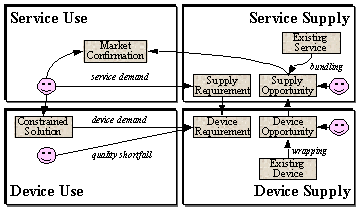
 |
requirements ecologyveryard projects > requirements > ecology |
| we offer | on this page | other material | links |
| consultancy
management briefings independent advice on tools and methods |
Three Approaches to Requirements Engineering | Ecological model of component supply |
 |
Three Approaches to Requirements Engineeringveryard projects > requirements > ecology > three approaches |
|
|
|
|
|
Identify "Users" Negotiate Requirements Define Solution |
Identify Domain
Identify Domain Experts Define Requirements Design Solution Kit |
Identify Ecosystem
Identify Services Procure & Release Devices Evolve Devices following Ecosystem Response |
But this approach assumes that it is meaningful to think about software requirements in terms of a fixed lump of functionality, known as the software system or application, delivered to a fixed community of users. It assumes that one person or team (possibly known as the system architect) has design control over this lump.
The limitations of this approach emerge when we are faced with large open distributed dynamic networks of software. It is both a business imperative and a technological imperative for business organizations to connect their business processes into these networks. These networks lack central design authority or architectural control, and evolve organically. Overall functionality and structure may change unpredictably from one day to the next. Connecting to these networks raises a number of difficult management dilemmas, including control, security and stability.
These networks are "Out of Control". Traditional engineering approaches are inadequate for operating effectively in this environment. Biological and ecological metaphors seem to have more relevance than engineering metaphors. [Reference: Kevin Kelly]
The ecological approach to creating software and services is radically different to the traditional engineering approach, and is based on biological and ecological metaphors.
| Business requirements
FOR components (pdf)
Business requirements AS components (pdf) |
 |
Requirement Triggersveryard projects > requirements > ecology > triggers |
Demand-driven. An agent may identify some service that he/she/it requires. This generates an unsatisfied service demand, which may be communicated to the service supply ecosystem in hopes of a response. Alternatively, the service demand may be translated into a device demand, and communicated from the device use ecosystem to the device supply ecosystem.
Supply-driven. A supplier may identify an opportunity to extend an existing service to increase its availability. Or to package a bundle of existing services and/or devices to provide a new service. An engineer may identify an opportunity to wrap or modify an existing device to provide new services. Prototype devices may be reengineered to increase availability of services.
Regardless of the initial stimulus, a successful component needs to find sufficient acceptability on the demand-side, and sufficient economies of scale on the supply-side. The requirements process needs to connect with both imperatives, but in no particular sequence.

| Ecological model of component supply |
 |
veryard projects > requirements > ecology |
Copyright © 1999-2003 Veryard Projects Ltd |